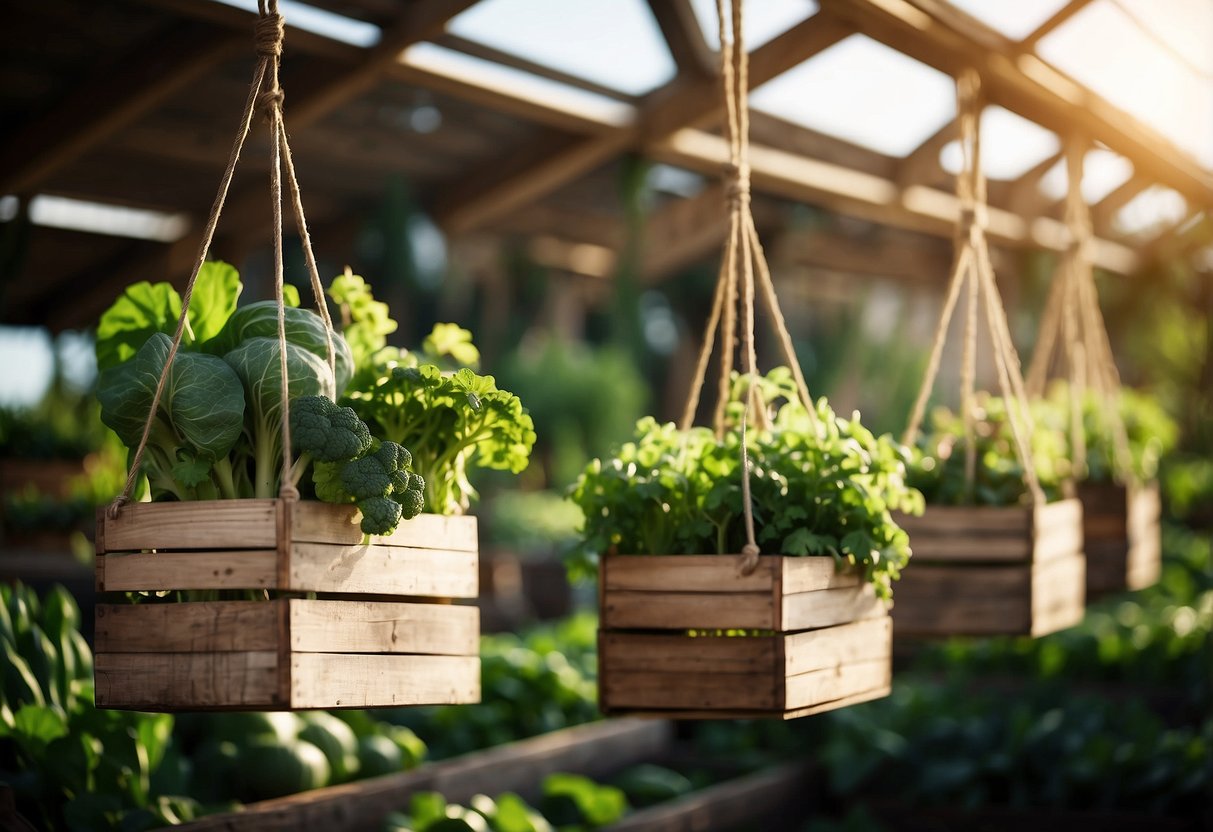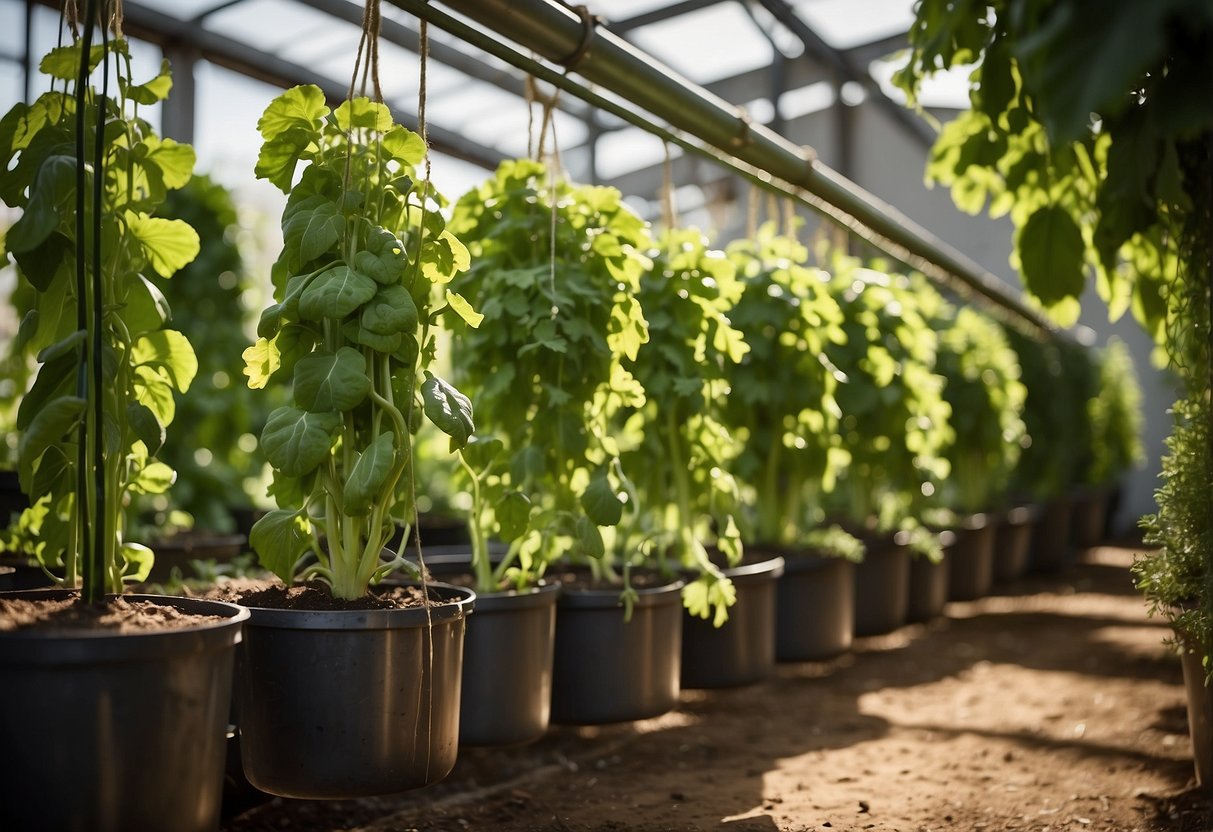Hanging Vegetable Garden Ideas: Creative Spaces for Fresh Produce
Gardening can be a relaxing and rewarding hobby, and hanging vegetable gardens provide a unique way to maximize your space. Whether you have a small balcony or a large yard, these gardens can fit just about anywhere.

Why settle for ordinary when you can elevate your garden experience? Hanging gardens are not only practical but also add a creative flair to your home. Ready to transform your gardening game? Let’s explore some exciting ideas to get you started.
1) Vertical Wall Planters

Vertical wall planters are a great way to use your space efficiently. You can attach planters directly to your wall or fence. This setup looks neat and allows you to grow many vegetables in a small area.
Consider using recycled materials like old bottles or wooden pallets. These planters are perfect for herbs, small peppers, and even leafy greens. It’s a fun project that will brighten your space and provide fresh produce. For more ideas, you can check out these unique vertical garden ideas.
2) Hanging Mesh Bags

Hanging mesh bags are great for small spaces. They let you grow veggies like cherry tomatoes or herbs without taking up floor space.
These bags offer good air circulation, helping to keep your plants healthy.
Just hang them on a sturdy hook or rod, and make sure they get enough sunlight.
Water regularly to keep them thriving. Consider using them for plants like spinach or greens that don’t need deep roots.
3) DIY Hanging Pallet Garden

You can create your own hanging pallet garden with a few simple tools. Start by finding a wooden pallet. Make sure it’s clean and safe to use. Sand it down to remove any rough spots.
Next, attach hooks or brackets to the top of the pallet. This will allow you to hang it securely. Line the inside with landscape fabric to hold the soil.
Fill the sections with potting mix and plant your favorite vegetables. Water them regularly and watch them grow. This project is perfect for spaces with limited ground area.
Check out more ideas on DIY Pallet Garden Projects.
4) Hanging Terracotta Pots

Hanging terracotta pots are a charming way to create a vertical vegetable garden. They add a rustic look to your garden space.
You can hang terracotta pots using sturdy rope or metal hangers. Choose smaller pots for herbs and leafy greens like spinach, which are lightweight.
Be mindful of the weight, as terracotta can be heavy when watered. Secure them well to prevent any accidents. For a unique touch, try painting the pots in bright colors.
5) Macrame Plant Hangers

Macrame plant hangers are a great option for your hanging vegetable garden. They can hold small pots, perfect for herbs or cherry tomatoes.
You can make a simple hanger with just a few knots. Use a strong cord and secure it tightly.
For ideas and patterns, check out these DIY macrame plant hanger patterns. Happy knotting!
6) Recycled Bottle Planters

Using recycled plastic bottles to create planters is a simple and eco-friendly way to start a hanging vegetable garden.
Cut the bottles in half and fill them with soil. Then, plant your seeds or seedlings into the soil.
You can hang these planters with strings or wires from balconies, porches, or any sturdy structure. They are perfect for small vegetables and herbs.
Check out these recycled bottle planter ideas for more inspiration.
7) Wooden Crate Hanging Planters

Wooden crate hanging planters are a great way to grow vegetables in small spaces. You can easily repurpose old crates and hang them on a wall or fence.
These planters work well with compact veggies like lettuce and radishes. Make sure to line the crates with landscape fabric to keep the soil in place. Water regularly to keep the plants healthy.
Using wooden crates adds a rustic charm to your garden. Plus, they are sturdy and can hold a good amount of soil.
8) Upside Down Tomato Planters

Upside down tomato planters are a creative way to grow tomatoes in a small space. They help reduce the risk of soil-borne diseases and improve air circulation around the plants.
To make one, you’ll need a bucket or similar container. Cut a hole in the bottom, insert the tomato plant, and fill with soil.
Hanging your planters not only saves space but also looks cool. These planters are perfect for balconies or small patios where ground space is limited.
9) Hanging Herb Garden

You can grow a variety of herbs right in your home with a hanging herb garden. It’s a great way to keep fresh herbs at your fingertips for cooking.
Use custom potted hanging herb gardens, which can fit even in small spaces like apartments. Another idea is to turn an Ikea bar cart into a vertical herb garden.
For an easy DIY project, you can make hanging shelves with terra-cotta pots. This creates a unique and practical display for your herbs.
10) Hanging Gutter Garden

A hanging gutter garden is a clever way to grow vegetables if you’re tight on space. You can repurpose old rain gutters for this project.
Simply attach the gutters to a wall or fence with strong brackets. Make sure to drill holes in the bottom for drainage.
These gardens work well for herbs, strawberries, and leafy greens. By hanging them, you keep plants off the ground and away from pests. Plus, they look really nice too.
For more details on creating a hanging gutter garden, check out these vertical DIY rain gutter garden ideas.
Benefits of Hanging Vegetable Gardens

A hanging vegetable garden can save space and improve the conditions for plant growth. You can enjoy gardening even in small areas while providing your plants with better airflow and more sunlight exposure.
Space-Saving Solution
Hanging vegetable gardens are perfect for small areas like balconies, patios, or even inside your home. They use vertical space, freeing up valuable ground space for other purposes.
You can grow a variety of vegetables in hanging containers, such as cherry tomatoes, spinach, and herbs. This allows you to maximize your gardening potential even in limited spaces. Additionally, hanging gardens reduce clutter and make it easier to move plants around as needed.
Using vertical space also means fewer weeds to manage. This can make gardening less labor-intensive and more enjoyable. In short, hanging gardens allow you to grow fresh vegetables without needing a traditional garden plot.
Improving Airflow and Sunlight Exposure
When plants are elevated, they benefit from better airflow, which helps them stay healthy. Improved airflow can reduce the risk of disease and pest infestations. Plants are less likely to develop mold or mildew when they have good circulation.
Hanging gardens also receive more sunlight exposure. Elevated plants can catch more hours of sunlight, as they are not shaded by other plants or structures. This is especially important for sun-loving vegetables like tomatoes and peppers.
Better sunlight exposure means more energy for photosynthesis, leading to healthier plants with higher yields. By hanging your vegetable garden, you give your plants the conditions they need to thrive.
Many different containers can be used for a hanging vegetable garden, like hanging flower pots or layered hanging clay pots, making it easy to find an option that suits your needs and space.
Choosing the Right Plants for Hanging Gardens

When selecting plants for your hanging garden, consider their size, weight, and sunlight needs. Certain vegetables are more suited for hanging baskets, while others benefit from companion planting for better growth and yield.
Suitable Vegetables
Hanging gardens are ideal for growing smaller, lightweight vegetables. Cherry tomatoes and plum tomatoes thrive in hanging baskets and are productive without needing extra support. Bush-type cucumbers are another great option because they save space and are highly productive. Spinach is lightweight, nutrient-dense, and well-suited for vertical gardening. You can also grow smaller vegetables like green onions and herbs such as basil and parsley, which do well in hanging pots or baskets.
Companion Planting Tips
Companion planting helps make the most of your hanging garden space and promotes healthy plant growth. Pair tomatoes with basil to enhance flavor and keep pests away. Spinach grows well with strawberries since they mutually benefit from each other’s growth patterns. For a diverse garden, plant lettuce with radishes, as radishes grow quickly and can be harvested before the lettuce takes up much space. You can also combine cucumbers with dill to save space and improve pest resistance. By choosing the right companions, you create a balanced and thriving hanging garden.
Maintenance Tips for Healthy Growth

Keeping your hanging vegetable garden healthy requires proper watering techniques and effective soil and fertilizer management. Paying attention to these areas will help your plants thrive and produce a bountiful harvest.
Watering Techniques
It’s crucial to water your plants correctly. Hanging gardens tend to dry out faster than traditional gardens because they are exposed to more air and wind. Check the soil moisture daily, especially in hot weather.
Use a watering can with a long spout to reach the plants easily. Water slowly to ensure the soil absorbs the moisture and reduce runoff. Morning watering is preferable because it allows the leaves to dry out during the day, preventing diseases.
If you’re growing thirsty plants like tomatoes or cucumbers, they may need daily watering. For plants that require less water, like peppers, you can water them every two to three days.
Soil and Fertilizer Management
Good soil is key to healthy plant growth. Use a light, well-draining potting mix designed for containers. This type of soil helps prevent root rot and other issues. Adding organic matter like compost can improve soil fertility.
Fertilize regularly, as nutrients can wash out of hanging baskets quickly. Use a balanced, water-soluble fertilizer every two weeks. If you notice yellowing leaves or slow growth, your plants might need more nutrients.
You can also use slow-release fertilizers that feed plants over time. Just mix them into the soil when planting, and they will gradually provide the necessary nutrients.







